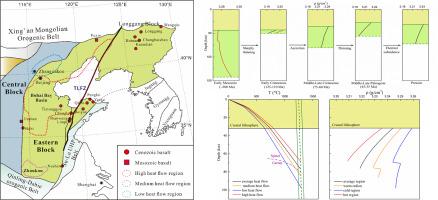当前位置:
X-MOL 学术
›
Gondwana Res.
›
论文详情
Our official English website, www.x-mol.net, welcomes your
feedback! (Note: you will need to create a separate account there.)
Constraining the density evolution during destruction of the lithospheric mantle in the eastern North China Craton
Gondwana Research ( IF 7.2 ) Pub Date : 2021-03-01 , DOI: 10.1016/j.gr.2020.12.001 Zhilin Ye , Dawei Fan , Qizhe Tang , Jingui Xu , Dongzhou Zhang , Wenge Zhou
Gondwana Research ( IF 7.2 ) Pub Date : 2021-03-01 , DOI: 10.1016/j.gr.2020.12.001 Zhilin Ye , Dawei Fan , Qizhe Tang , Jingui Xu , Dongzhou Zhang , Wenge Zhou

|
Abstract The thermoelastic properties of minerals in mantle xenoliths combined with the thermal states can provide an integrated understanding of the petrophysics of the lithospheric mantle. Here, we conducted high-pressure and high-temperature experiments on the main minerals (e.g. olivine, orthopyroxene, clinopyroxene, spinel, and garnet) in peridotite xenoliths from basalt of the eastern North China Craton (NCC) using in situ synchrotron single-crystal X-ray diffraction combined with diamond anvil cells. The pressure-temperature-volume data were fitted to the third-order Birch-Murnaghan equations of state and yielded the thermoelastic parameters that included bulk modulus, pressure and temperature derivatives, and thermal expansion coefficients. The density profiles of the eastern NCC during the destruction process since the Mesozoic are presented from the temporal and spatial aspects. The lithospheric density dramatically decreased during destruction, and high heat flow may have been a trigger. The spatially distributed density profile also provides firm evidence for lateral heterogeneities in the eastern NCC. This may suggest that the present mantle is characterized by heterogeneous destruction of the NCC.
中文翻译:

华北克拉通东部岩石圈地幔破坏过程中密度演化的约束
摘要 地幔包体中矿物的热弹性性质与热态相结合,可以提供对岩石圈地幔岩石物理学的综合理解。在这里,我们使用原位同步加速器单晶对华北克拉通东部玄武岩橄榄岩包体中的主要矿物(例如橄榄石、斜方辉石、单斜辉石、尖晶石和石榴石)进行了高压和高温实验。 X 射线衍射结合金刚石砧座细胞。压力-温度-体积数据符合三阶 Birch-Murnaghan 状态方程,并得出包括体积模量、压力和温度导数以及热膨胀系数在内的热弹性参数。从时空两方面展示了中生代以来华北克拉通东部破坏过程的密度剖面。岩石圈密度在破坏过程中急剧下降,高热流可能是触发因素。空间分布的密度剖面也为 NCC 东部的横向异质性提供了确凿的证据。这可能表明当前地幔的特征是 NCC 的异质破坏。
更新日期:2021-03-01
中文翻译:

华北克拉通东部岩石圈地幔破坏过程中密度演化的约束
摘要 地幔包体中矿物的热弹性性质与热态相结合,可以提供对岩石圈地幔岩石物理学的综合理解。在这里,我们使用原位同步加速器单晶对华北克拉通东部玄武岩橄榄岩包体中的主要矿物(例如橄榄石、斜方辉石、单斜辉石、尖晶石和石榴石)进行了高压和高温实验。 X 射线衍射结合金刚石砧座细胞。压力-温度-体积数据符合三阶 Birch-Murnaghan 状态方程,并得出包括体积模量、压力和温度导数以及热膨胀系数在内的热弹性参数。从时空两方面展示了中生代以来华北克拉通东部破坏过程的密度剖面。岩石圈密度在破坏过程中急剧下降,高热流可能是触发因素。空间分布的密度剖面也为 NCC 东部的横向异质性提供了确凿的证据。这可能表明当前地幔的特征是 NCC 的异质破坏。











































 京公网安备 11010802027423号
京公网安备 11010802027423号